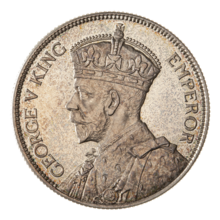New Zealand | |
| Value | 2s (£NZ) |
|---|---|
| Mass | 11.31 g |
| Diameter | 28.60 mm |
| Edge | Milled |
| Composition | 1933–1946: 50% silver, 50% quaternary alloy 1947–1965: cupronickel (75% copper, 25% nickel) |
| Years of minting | 1933-1965 |
| Obverse | |
 | |
| Design | Crowned bust of George V |
| Designer | Percy Metcalfe |
| Reverse | |
 | |
| Design | A kiwi |
| Designer | George Kruger Gray |
The florin is a coin issued for the New Zealand pound from 1933 to 1965, equal to two shillings or twenty-four pence. The coin features a kiwi on the reverse and the reigning monarch on the obverse. It was introduced in 1933 as part of the first issue of New Zealand pound coinage, due to shortages of British silver coins resulting from the devaluation of local currency relative to the pound sterling. A lengthy design process was further protracted due to differing proposed design motifs between the Royal Mint, supporting a reverse design featuring heraldic ships, and the Gordon Coates–appointed Coinage Committee's proposed kiwi design. This disagreement led to almost a dozen proposed designs and revisions before the finalised issue entered circulation in February 1934. Initially struck in silver by the Royal Mint to replace the previous imperial florin, it was struck in cupronickel from 1947 due to rising precious metal prices. While proposed as the base of a decimalised New Zealand coinage since the 1930s, the florin was ultimately replaced in 1967 by the coinage of the New Zealand dollar. Florins remained legal tender with a value of 20 cents until 31 October 2006.[1]
